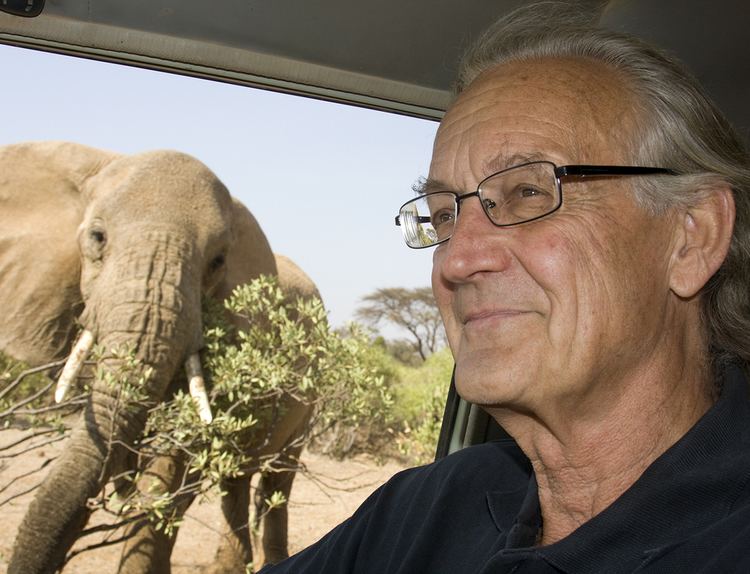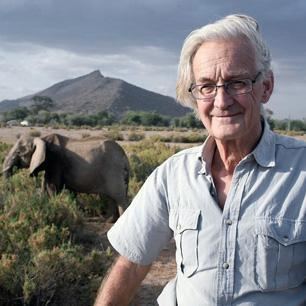Name Iain Douglas-Hamilton Nationality British Role Zoologist | Spouse Oria Rocco (m. 1971) | |
 | ||
Born 16 August 1942 (age 83) ( 1942-08-16 ) Known for Study of elephant behaviour Children Saba Douglas-Hamilton, Mara Moon Douglas-Hamilton Books Among the elephants, Battle for the elephants, The Elephant Family Book Parents Prunella Stack, Lord David Douglas-Hamilton Similar People Saba Douglas‑Hamilton, Frank Pope, Prunella Stack, Peter McBride | ||
Green google dr iain douglas hamilton founder of save the elephants
Iain Douglas-Hamilton CBE (born 16 August 1942) is a zoologist known for his study of elephants. He earned both a BSc in biology and a D.Phil. in zoology from Oriel College, Oxford, and he is the recipient of the 2010 Indianapolis Prize for his work on elephant conservation. His chief research interest is to understand elephant choices by studying their movements. In 1993, he founded the organisation Save the Elephants. He is a frequent keynote speaker at the annual Wildlife Conservation Network expo.
Contents
- Green google dr iain douglas hamilton founder of save the elephants
- Iain douglas hamilton on african elephant conservation
- Family
- Manyara
- Counting Elephants
- The elephant holocaust and the international ivory trade ban
- Save The Elephants
- The Poaching Crisis
- Awards works and publications
- References

Iain douglas hamilton on african elephant conservation
Family

Douglas-Hamilton is the son of Lord David Douglas-Hamilton, a World War II Royal Air Force officer and Spitfire pilot, and Ann Prunella Stack, a women's rights activist, and he has an elder brother, Diarmaid. He was born in Dorset, UK, attended Gordonstoun School in Scotland between 1955 and 1960, and went on to study Zoology at Oxford University, earning first a bachelor's degree, in 1965, and then a D.Phil, in 1972. He is married to Oria Douglas-Hamilton, Founder of Elephant Watch Camp (a luxury tented camp with the highest eco-credentials, located in Samburu National Reserve), with whom he has two daughters, Saba, a documentary film-maker and television presenter, and Dudu, a documentary producer. He and his family live in Kenya.
Manyara

At the age of 23, Douglas-Hamilton moved to Tanzania to live in the wild in Lake Manyara National Park, where he carried out the first scientific study of the social interactions of the African elephant. From that study came his hypothesis, rooted in behavioural ecology, that elephant movements could hold the key to understanding their reactions to their changing environments. Douglas-Hamilton argues that collecting and analysing large amounts of data on elephant locations and migrations can lead to insights into their choices, and therefore assist in their protection against rising threats, including poaching and human-wildlife conflict.
Counting Elephants

Douglas-Hamilton initially developed techniques to monitor widespread elephant movements from the air. In the early 1970s, he designed study methods that would allow for comprehensive and replicable surveys of elephant families from low-flying aircraft, which would at the same time allow large population counts to be undertaken for the first time. Between 1976 and 1979, Douglas-Hamilton worked on a joint IUCN /WWF Elephant Survey and Conservation Programme, which surveyed African elephant populations in 34 countries to produce scientific data to help shape policy recommendations for the species' protection. Around the same time, working for IUCN, Douglas-Hamilton undertook research to map out the scale of the world ivory trade, its value, and its regulations. Meanwhile, he continued to direct aerial surveys of elephant populations into the 1980s, including in Uganda, Tanzania and the Central African Republic.
The 'elephant holocaust' and the international ivory trade ban
Douglas-Hamilton's aerial surveys, coupled with research coming from other studies, began to show for the first time the scale of the poaching crisis that was sweeping Africa during the 1970s and 1980s, as demand for ivory from Asia, in particular from Japan, grew. From 1980 to 1982, Douglas-Hamilton was made Honorary Chief Park Warden and anti-poaching advisor to Uganda's national parks authority. There, he designed air and ground patrols against poachers, many from Sudan, where civil war was raging and poached elephant ivory could be sold to raise money to buy weapons. On occasion, Douglas-Hamilton was shot at as he carried out his work. His work in Uganda helped to stem the loss of elephants to poachers, and allowed him to highlight the potential ways that poachers could be stopped in other parts of Africa, using the methods he developed in Uganda. Douglas-Hamilton's estimates, drawn from his research and that of others, suggested that the minimum population of African elephants across the continent of 1.3 million individuals in 1979 had been reduced to less than half, or around 600,000 elephants, by 1989. These statistics illustrated to the world the scale of what became known as the elephant holocaust. Regulation of the trade was attempted, via the Convention on the International Trade in Endangered Species, but eventually it was globally accepted that a ban should be enforced to stem the loss of illegally killed elephants. Douglas-Hamilton was among Africa's leading conservationists who argued for this position. It is widely accepted that the ban worked, and elephant populations, especially savannah populations, began to recover.
Save The Elephants
The first 20 years of Douglas-Hamilton's work had illustrated that close scientific study of elephant populations, coupled with surveys of their ranges and movements, could help to mould policies that could protect them from external changes. To build on this work, in 1993 Douglas-Hamilton founded Save The Elephants, a charity registered in the UK and headquartered in Nairobi with its main research station in Samburu National Reserve in northern Kenya. Its mission is "to secure a future for elephants" by preserving the environments in which the animals live and encouraging a tolerant relationship between elephant and human populations (http://savetheelephants.org/about/). Collection of scientific data continues to drive Douglas-Hamilton’s work with Save The Elephants, both with the aerial surveys that he pioneered early in his career, and increasingly with modern technology including tracking collared elephants by GPS and satellites. Save The Elephants has since its formation been studying herds resident or migratory to Samburu National Reserve – a cohort of roughly 500 individuals. Hundreds of elephants have been darted and fitted with collars carrying computer chips that communicate via satellites or mobile telephone networks with the charity's computer databases. From the initial collaring and monitoring of herds in Samburu, Douglas-Hamilton and Save The Elephants has gone on to use the same methods to study elephant populations in Mali, the Central African Republic and South Africa.
Alongside its focus on data collection, Douglas-Hamilton has directed Save The Elephants to increase its work on reducing the conflict between growing human populations and elephant herds.
The Poaching Crisis
Douglas-Hamilton, and others, argue that 'one-off' sales of seized ivory stockpiled by the governments of South Africa, Zimbabwe, Namibia and Botswana to China and Japan in 2002 and 2008 kick-started a return of uncontrolled illegal poaching of Africa's elephants that is "far graver" even than during the 1970s and 1980s. (http://voices.nationalgeographic.com/2013/01/31/time-running-out-to-save-elephants-from-ivory-trade/). Douglas-Hamilton and others estimate that between 2010 and 2012, more than 100,000 African elephants were illegally killed, and there is little sign since that the rate has reduced. The increased price of ivory is to blame. Since 2007, the price paid for elephant tusks has doubled in the area around Samburu National Reserve, Douglas-Hamilton testified in 2012 to the Committee on Foreign Relations at the US Senate as part of high-level investigations into the links between resurgent ivory poaching in Africa and insecurity. The price of ivory in markets in China, especially, and Asia generally, has also increased, driven by demand from growing middle classes keen to display their wealth, and speculators hoarding ivory against expected price rises following a new trade ban, or the extinction of the African elephant.
Douglas-Hamilton, echoing colleagues in the field, highlighted to the US Senate committee that current poaching trends could only be stemmed with increased anti-poaching efforts in African range states, better enforcement of laws against poaching, smuggling and money-laundering, and campaigns to reduce the demand for ivory products in Asia. Douglas-Hamilton and Save The Elephants worked with WildAid, an American charity dedicated to reducing the demand for products from endangered animals, to host Yao Ming, one of China's best-known sports personalities, during a fact-finding tour of Kenya in 2012. His campaign and others in China have helped to reduce the demand for ivory products, surveys showed.
Douglas-Hamilton says he remains "an optimist" that this second spike in poaching can be contained: "I've been through all of this before in the 70s and 80s. As a collective group we stopped that killing, and in the savannahs there was a reprieve of 20 years. I believe we can do it again,” he has said.
Awards, works and publications
Douglas-Hamilton is the recipient of many awards for his research and his work to protect Africa's elephants, including the 2010 Indianapolis Lilly Award, a major global award for animal conservation, for which he had previously been a finalist in 2006 and 2008. He also received the George B Rabb Conservation Medal of the Chicago Zoological Society in 2014, the Disney Wildlife Conservation Fund Award in 2006, the Dawkins Prize for Conservation and Animal Welfare in 2001, and others for his writing work prior to that.
Douglas-Hamilton is a member of the Technical Advisory Group to CITES for monitoring the illegal killing of elephants (MIKE) in Africa, a trustee of the Kenya Elephant Research Fund, a member since 1982 of the IUCN African Elephant Specialist Group, and currently a member of its African Elephant Data Review Working Group, and from 1993 to 2004 he was a wildlife and environmental consultant to the European Union and the US Fish and Wildlife Service.
Douglas-Hamilton has published a long list of academic research papers throughout his career. He is the author, with his wife Oria, of Battle for the Elephants (Viking, 1992) and Among The Elephants (Doubleday, 1975), and has worked with documentary filmmakers as a technical advisor and expert.
